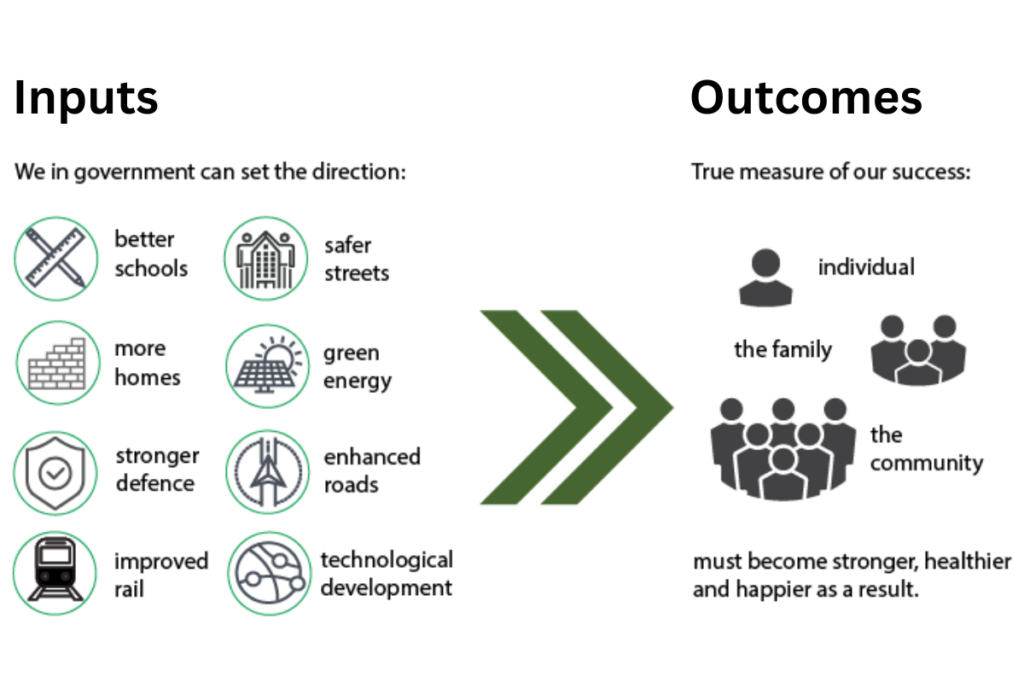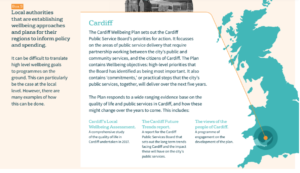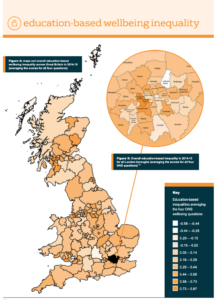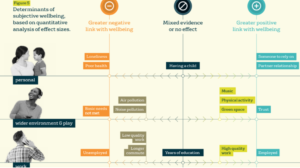Wellbeing at the heart of the 2020 Spending Review?
We believe the purpose of public policy and community action is to improve people’s lives. Along with many civil society organisations who have been working on this for decades before us, we call this aim wellbeing.
Wellbeing is ‘how we’re doing, as individuals, communities and as a nation and how sustainable it is for the future’ and is also known in the HM Treasury Green Book as social welfare or social value.
Proxy measures of societal wellbeing, including GDP and life expectancy, remain important, alongside an understanding of success according to a broader range of indicators within policy areas.
Richard Stone, winner of the Nobel Prize in economics in 1984, noted in his lecture:
“The three pillars on which an analysis of society ought to rest are studies of economic, socio-demographic and environmental phenomena…”
“…environmental issues, such as pollution, land use and non-renewable resources, offer plenty of scope for accounting. But I have done little work in this area and so I shall do no more than mention what I called at the beginning of my lecture the third pillar on which the study of society should rest”.
This would be a fuller version of our version of our national accounts and its satellites in the Blue Book. It would include investment in our future through human, economic, social and natural ‘capitals’.
By adopting a wellbeing approach to public policy we want to create the conditions for us all to thrive; and to meet our needs to feel safe, loved and fulfilled. This is not the job of the public sector alone but their role is an important one.
Impact
“The success of spending decisions is measured by their impact on people’s lives.”
Chancellor Rt Hon Rishi Sunak MP
There are good questions about whether the policies and spending outlined in the spending review will or will not be the right choices. Here, we focus on some of the technical aspects of the spending review that will help us to understand whether we will know if they are.
The 2020 spending review does a couple of interesting things:
Firstly, it continues a renewed focus on the outcomes of spending started by former Chancellor Rt Hon Sajid Javid MP. This includes a cross-departmental focus, and uses evaluation to understand how best achieve these outcomes:
- Priority and cross cutting outcomes – Three to four priority outcomes with associated metrics are set out for each department to support understanding of Public Value. This includes tricky cross cutting outcomes and a number of multi-department projects. Keeping these coalitions together in the day to day reality of policy delivery will be key to success – it will need great leadership, good management and engagement and, crucially, a shared evidence base.
- Progress on the outcome measures – Progress will be regularly reported back to departments and be publicly available to citizens. This is important because sustained high performance requires rapid, relevant, high-quality feedback to inform learning and action. Progress needs all the players to see the target and helps all organisations involved – public, private and civil society – take action.
- Evidence and evaluation – As part of this stronger focus on outcomes, the government is placing greater emphasis on the importance of high-quality evaluation, which is critical to understanding what works.
Secondly, it points to changes in the HMT Green Book guidance to address ‘levelling up’ and how policies and investments will impact different places. This includes a commitment to publish supplementary guidance on Valuation of Wellbeing following peer review, which builds on the work of the Centre and its teams.

Notable gaps
We have identified four areas where a greater focus is needed on joining up the drivers of wellbeing within the Spending Review:
- Health and job quality – We know that what makes us healthy is largely beyond access to healthcare. Looking at the departmental outcomes there is a gap in outcomes around becoming healthier and happier rather than only the delivery of healthcare. The new experimental health index announced by the Office of National Statistics this week may go some way to addressing this. This should go alongside the Job Quality Index proposed by the Taylor Review and the Industrial Strategy Success Metrics.
- Children and young people – One of the surprising things we’ve noticed is that there hasn’t been a common way of looking at best outcomes for children and young people across departments and sectors, given the numbers that care and act in this area. The Spending Review includes a pilot with a wide range of departments trying out improvements to how data is used to inform policy decisions and service delivery for children and young people. What is in the best interests of the child? How do we know? We are working with the Health Foundation and the Children’s Society on a new project measuring children and young people’s wellbeing.
- Relationships, Communities and Families – Relationships are key to our wellbeing and addressing this is another challenge that reaches across Government and beyond. The spending review highlights a DfT led loneliness project, delivering the DCMS led Loneliness Strategy, along with a commitment to rationalise the Office for Civil Society. Joining these areas up coherently will be key. Measuring the impact of policies across areas of Government action, policy interests and population groups is also important but difficult. The Green Book highlights changes to the DWP led family test, the Equalities Act analysis and the possibility of weighting more highly improvements in income for the very low paid (this in particular is important because it makes a bigger difference to wellbeing).
- Social Value Act procurement guidance – The final gap that we have noticed is that this guidance, published in September, does not seem to join up with either the Green Book or the Spending Review thinking. This seems an oversight in implementation – an area identified in the Green Book review as an issue.
Why does this matter?
A wellbeing framework (such as the ONS wellbeing framework, OECD Better Life Index or New Zealand Living Standards Framework) provides the data on ‘what matters’ to help inform priority setting and decision making. An example of this is in Wales, where local area wellbeing assessments are the shared data resource for all public bodies in a local area.

Goal setting in this context is the action plan for improving societal wellbeing. Examples are the Wellbeing of Future Generations Goals, Sustainable Development Goals and in New Zealand through their wellbeing budget priorities. That the Sustainable Development Goals are led in the UK by an international facing department, now FCDO, tends towards forgetting that they are for people in the UK too – an interesting international/domestic social policy silo example.
Levelling up
Nations with high wellbeing have fewer people in misery and reduced wellbeing inequalities – where people can have a good quality of life wherever they live and work.
‘To help people get on, the government is taking steps to strengthen skills and education, and support wellbeing across every region of England.’ Spending Review 3.12
Our analysis of wellbeing inequalities in Britain and the drivers of those inequalities are a good place to start to understand how to achieve this. It demonstrates the challenge of trying to improve growth, and the necessary work of tackling climate change.
For example – in places where wellbeing is more equal, air quality can often be worse. This is explained, in part, by the drivers of subjective wellbeing – that a job, and the transport to get to it, weighs more than the environmental impacts. If we are to effectively tackle climate change, we have to square this circle. Maybe the seed of hope is in the wellbeing equaliser of ‘engagement with green space’?

What should be prioritised?
The challenge with frameworks that consider multiple outcomes is that we still have to make choices and prioritise. Life satisfaction and related metrics offer a way to do that across policy areas.
We don’t yet have an office of state doing a ‘wellbeing outlook’ like the OBR but I think it’s fair to say it could be challenging. The short answer, in terms of what has the biggest impact on our wellbeing is:
- Our health – physical and mental
- Our partner relationships
- Our jobs.

Covid-19, employment and wellbeing
We know that there has been a rise in unemployment over the last 6 months and we are expecting more difficult economic news. Some of the strongest evidence we have is on the immediate and long term harms of unemployment, including its impact on future health.
- It is vital to protect jobs and, where we cannot, to aim for re-employment within a year. Where we cannot do this, the effect is as important for our longer term wellbeing as immediate harms.
- Lifelong learning, to support re-skilling and moving to new roles, at any stage of life or career is an important part of supporting employment and job quality throughout life as well as directly contributing to improving wellbeing.
Given the twin public health and economic crises arising from Covid-19, we are also going to need a lot of our resilience to come from the ‘third pillar’ – the strength of our social fabric. Our relationships at all levels, close family and friends and neighbourhood connections both from people like us and those we don’t normally mix with, our ‘associational life’ – both professional and social – in our communities, as well as the big picture stores of fairness, shared social norms, values and trust in our institutions.
Further reading on the spending review and wellbeing budgets
- We’ve been looking for some time at what a spending review for wellbeing would look like – here in 2019, here in 2017 and also here. This is the APPG Wellbeing Economics’ take too.
- This is our early thinking on governance for wellbeing and our Wellbeing at the Heart of Policy report from earlier this year.
- Many of you will be familiar with the New Zealand Wellbeing Budget based on the Living Standards Framework similar to the OECD Better Life Index, the UK Office for National Statistics Wellbeing Framework too and those in Scotland, Wales and Northern Ireland.
